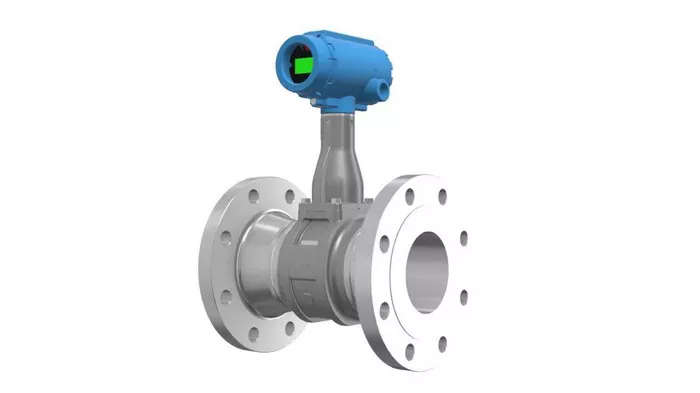Flow measurement is a critical aspect in many industrial processes, from water treatment facilities to food manufacturing plants. Among the many devices used for this purpose, electromagnetic flow meters stand out due to their reliability, accuracy, and ability to handle a wide range of fluid types. These meters, often referred to as mag meters, are unique in their operation, employing Faraday’s law of electromagnetic induction to measure the velocity of conductive fluids.
How Do Electromagnetic Flow Meters Work
The fundamental working principle of electromagnetic flow meters is based on Faraday’s law, which states that a voltage will be induced when a conductor moves through a magnetic field. In the context of flow measurement, the fluid itself acts as the conductor. Two electrodes mounted in the pipe wall detect the induced voltage, which is directly proportional to the flow velocity of the fluid. By knowing the cross-sectional area of the pipe, the flow rate can be precisely calculated.
Key Components of an Electromagnetic Flow Meter
To achieve accurate readings, electromagnetic flow meters are constructed with several crucial components:
- Flow Tube: The section where the fluid passes through, lined with a non-conductive material to prevent electrical interference.
- Electrodes: Positioned along the flow tube to capture the voltage generated by the moving fluid.
- Magnetic Coils: Create the magnetic field necessary for operation.
- Transmitter: Converts the electrode signals into a readable flow value, often integrating with industrial instrumentation systems.
Types of Electromagnetic Flow Meters
While the basic principle remains consistent, electromagnetic flow meters are available in several types to cater to specific application needs:
- Inline Electromagnetic Flow Meters: Installed directly into the pipeline, ideal for permanent setups requiring high accuracy.
- Insertion Electromagnetic Flow Meters: Inserted into existing pipes, suitable for large pipe sizes and temporary measurements.
- Battery-Operated Mag Meters: Designed for remote areas without a stable power supply, ensuring continuous monitoring capabilities.
Applications of Electromagnetic Flow Meters
Due to their versatility and robustness, electromagnetic flow meters are employed across various industries, including:
- Water and Wastewater Treatment: Monitoring the flow of sewage and treated water.
- Food and Beverage Industry: Measuring viscous and hygienic fluids like milk, juices, and syrups.
- Mining and Minerals: Handling abrasive slurries with high solid content.
- Chemical Processing: Monitoring aggressive and corrosive liquids.
Advantages of Electromagnetic Flow Meters
Several factors make electromagnetic flow meters a preferred choice over traditional flow measuring instruments:
- No Moving Parts: Minimizes maintenance and increases durability.
- Wide Range of Sizes: Available from small pipelines to large channels.
- Unaffected by Fluid Properties: Viscosity, density, and temperature variations have minimal effect on accuracy.
- High Accuracy and Reliability: Capable of maintaining consistent performance in harsh environments.
Limitations of Electromagnetic Flow Meters
Despite their advantages, electromagnetic flow meters are not without drawbacks:
- Conductive Fluids Only: Non-conductive fluids like hydrocarbons cannot be measured.
- Cost: Higher initial investment compared to some mechanical alternatives.
- Installation Requirements: Proper grounding and straight pipe runs are essential for accurate measurements.
Comparison with Other Flow Meter Technologies
Understanding how electromagnetic flow meters stack up against other technologies helps in selecting the right device for specific applications:
Electromagnetic Flow Meters vs. Thermal Mass Flow Meters
Thermal mass flow meters measure the mass flow rate of gases using thermal properties rather than fluid velocity. While electromagnetic flow meters are better suited for conductive liquids, thermal mass flow meters excel in gas applications and offer direct mass flow readings without needing temperature and pressure compensation.
Electromagnetic Flow Meters vs. Vortex Flow Meters
Vortex flow meters detect the vortices shed by an object placed in the flow stream. They are versatile and can measure gas, steam, and liquids but are generally more sensitive to vibration and piping stress than electromagnetic meters.
Selecting the Right Electromagnetic Flow Meter
Choosing the correct electromagnetic flow meter involves evaluating several critical factors:
- Fluid Conductivity: Ensure the fluid’s conductivity meets the device’s minimum requirements.
- Pipe Size and Installation Space: Larger pipes might require insertion-type meters.
- Environmental Conditions: Assess the impact of temperature, pressure, and surrounding electromagnetic fields.
- Industry Standards and Certifications: Check for compliance with standards relevant to your industry.
Maintenance and Calibration
Although electromagnetic flow meters require minimal maintenance due to the absence of moving parts, regular calibration ensures ongoing accuracy. Typical maintenance activities include:
- Cleaning electrodes to remove buildup from scaling or biological growth.
- Inspecting the liner for signs of wear or chemical damage.
- Verifying electrical connections and grounding systems.
- Conducting in-situ verification tests using portable calibration equipment.
Conclusion
Electromagnetic flow meters have cemented their place as essential tools in modern fluid measurement thanks to their precision, robustness, and adaptability. Whether in water treatment plants, food processing facilities, or chemical industries, these meters ensure accurate and reliable flow monitoring. As technologies continue to evolve, mag meters are poised to become even more intelligent, efficient, and indispensable in industrial instrumentation applications. Understanding their working principles, strengths, and limitations empowers engineers and technicians to select and maintain the best flow measurement solutions for their specific needs.

